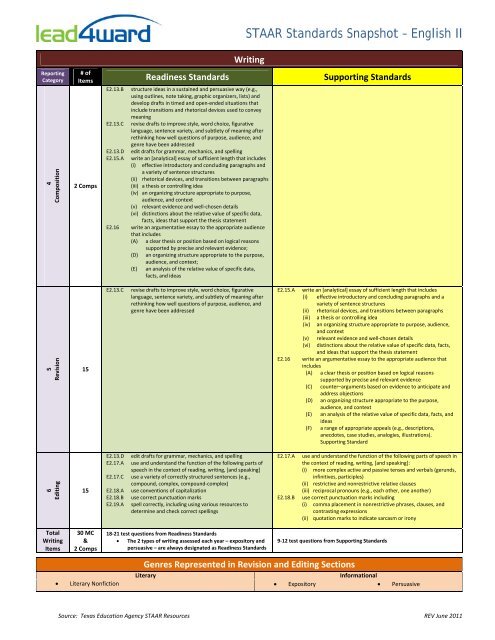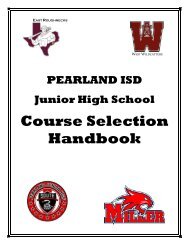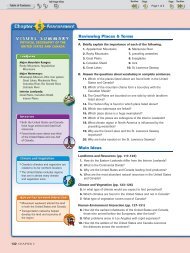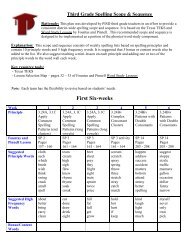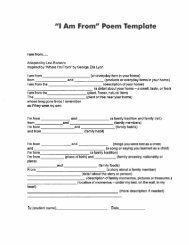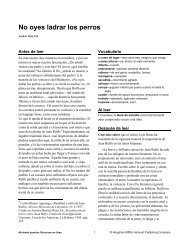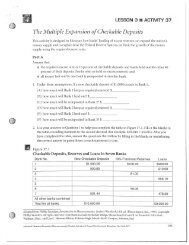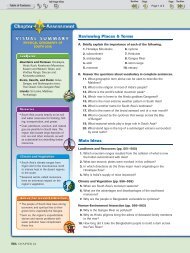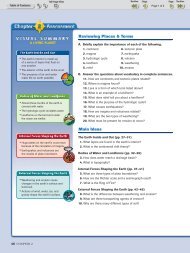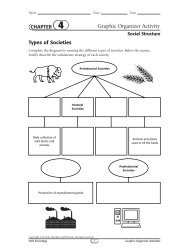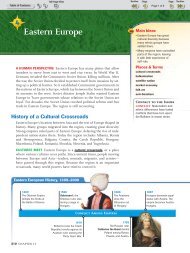STAAR Standards Snapshot English II - Pearland
STAAR Standards Snapshot English II - Pearland
STAAR Standards Snapshot English II - Pearland
Create successful ePaper yourself
Turn your PDF publications into a flip-book with our unique Google optimized e-Paper software.
<strong>STAAR</strong> <strong>Standards</strong> <strong>Snapshot</strong> – <strong>English</strong> <strong>II</strong><br />
Reporting<br />
Category<br />
4<br />
Composition<br />
# of<br />
Writing<br />
Items<br />
Readiness <strong>Standards</strong> Supporting <strong>Standards</strong><br />
2 Comps<br />
E2.13.B structure ideas in a sustained and persuasive way (e.g.,<br />
using outlines, note taking, graphic organizers, lists) and<br />
develop drafts in timed and open‐ended situations that<br />
include transitions and rhetorical devices used to convey<br />
meaning<br />
E2.13.C revise drafts to improve style, word choice, figurative<br />
language, sentence variety, and subtlety of meaning after<br />
rethinking how well questions of purpose, audience, and<br />
genre have been addressed<br />
E2.13.D edit drafts for grammar, mechanics, and spelling<br />
E2.15.A write an [analytical] essay of sufficient length that includes<br />
(i) effective introductory and concluding paragraphs and<br />
a variety of sentence structures<br />
(ii) rhetorical devices, and transitions between paragraphs<br />
(iii) a thesis or controlling idea<br />
(iv) an organizing structure appropriate to purpose,<br />
audience, and context<br />
(v) relevant evidence and well‐chosen details<br />
(vi) distinctions about the relative value of specific data,<br />
facts, ideas that support the thesis statement<br />
E2.16 write an argumentative essay to the appropriate audience<br />
that includes<br />
(A) a clear thesis or position based on logical reasons<br />
supported by precise and relevant evidence;<br />
(D) an organizing structure appropriate to the purpose,<br />
audience, and context;<br />
(E) an analysis of the relative value of specific data,<br />
facts, and ideas<br />
5<br />
Revision<br />
15<br />
E2.13.C<br />
revise drafts to improve style, word choice, figurative<br />
language, sentence variety, and subtlety of meaning after<br />
rethinking how well questions of purpose, audience, and<br />
genre have been addressed<br />
E2.15.A write an [analytical] essay of sufficient length that includes<br />
(i) effective introductory and concluding paragraphs and a<br />
variety of sentence structures<br />
(ii) rhetorical devices, and transitions between paragraphs<br />
(iii) a thesis or controlling idea<br />
(iv) an organizing structure appropriate to purpose, audience,<br />
and context<br />
(v) relevant evidence and well‐chosen details<br />
(vi) distinctions about the relative value of specific data, facts,<br />
and ideas that support the thesis statement<br />
E2.16 write an argumentative essay to the appropriate audience that<br />
includes<br />
(A) a clear thesis or position based on logical reasons<br />
supported by precise and relevant evidence<br />
(C) counter–arguments based on evidence to anticipate and<br />
address objections<br />
(D) an organizing structure appropriate to the purpose,<br />
audience, and context<br />
(E) an analysis of the relative value of specific data, facts, and<br />
ideas<br />
(F) a range of appropriate appeals (e.g., descriptions,<br />
anecdotes, case studies, analogies, illustrations).<br />
Supporting Standard<br />
6<br />
Editing<br />
15<br />
E2.13.D<br />
E2.17.A<br />
E2.17.C<br />
E2.18.A<br />
E2.18.B<br />
E2.19.A<br />
edit drafts for grammar, mechanics, and spelling<br />
use and understand the function of the following parts of<br />
speech in the context of reading, writing, [and speaking]<br />
use a variety of correctly structured sentences (e.g.,<br />
compound, complex, compound‐complex)<br />
use conventions of capitalization<br />
use correct punctuation marks<br />
spell correctly, including using various resources to<br />
determine and check correct spellings<br />
E2.17.A<br />
E2.18.B<br />
use and understand the function of the following parts of speech in<br />
the context of reading, writing, [and speaking]:<br />
(i) more complex active and passive tenses and verbals (gerunds,<br />
infinitives, participles)<br />
(ii) restrictive and nonrestrictive relative clauses<br />
(iii) reciprocal pronouns (e.g., each other, one another)<br />
use correct punctuation marks including<br />
(i) comma placement in nonrestrictive phrases, clauses, and<br />
contrasting expressions<br />
(ii) quotation marks to indicate sarcasm or irony<br />
Total<br />
Writing<br />
Items<br />
<br />
30 MC<br />
&<br />
2 Comps<br />
Literary Nonfiction<br />
18‐21 test questions from Readiness <strong>Standards</strong><br />
The 2 types of writing assessed each year – expository and<br />
persuasive – are always designated as Readiness <strong>Standards</strong><br />
9‐12 test questions from Supporting <strong>Standards</strong><br />
Genres Represented in Revision and Editing Sections<br />
Literary<br />
Informational<br />
Expository Persuasive<br />
Source: Texas Education Agency <strong>STAAR</strong> Resources REV June 2011


